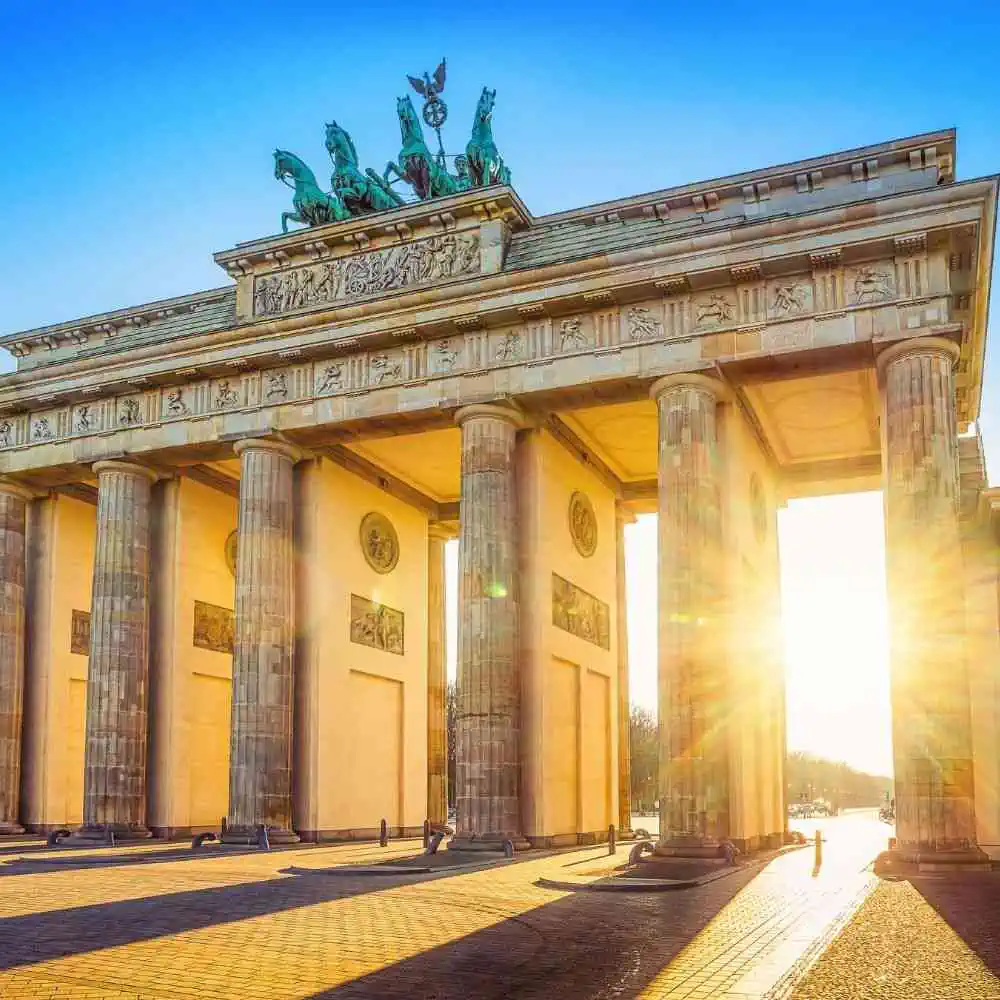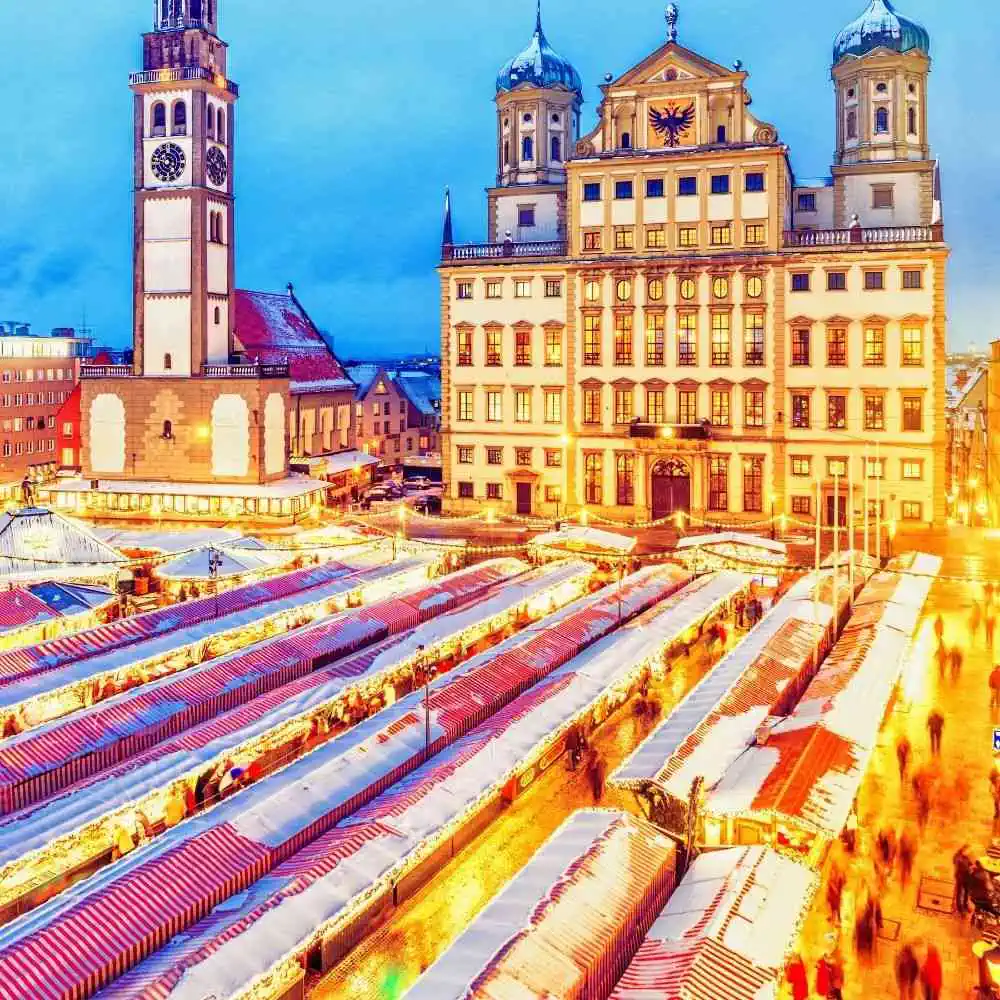Partirás desde Augsburg Hbf, ubicado justo en el centro de la ciudad de Augsburg Hbf, y disfrutarás del hermoso paisaje mientras llegas a Berlin Hbf, también situada en el corazón de Berlín.
Trenes de Augsburg Hbf a BerlínDesde € 40.00
Trenes de Augsburg Hbf a Berlín
Viaje en tren de Augsburg Hbf - Berlín
For those who’re planning to explore Germany, an epic train journey from Augsburg to Berlin is one of the most iconic trips you’ll ever experience. You’ll be travelling from the second largest city of the Free State of Bavaria to Germany’s capital city, passing through some of the most iconic cities and towns along the way.
The shortest duration for the journey is 5 hours and 4 minutes, and you’ll be travelling a total distance of 520.3 km. As you travel through Bavaria, you’ll be passing through main stations such as Ingolstadt, Nuremberg, Wurzburg, Kassel and Hanover. Along the way, you can experience some of the most iconic German towns, such as Dinkelsbühl, Erfurt and Magdeburg.
As you depart from Augsburg, be sure to look out for the iconic Town Hall, and the magnificent Rotes Tor (Red Gate), which is a symbol of the city’s history. When you arrive in Berlin, be sure to check out the elaborate Brandenburg Gate, one of the most iconic landmarks in the city.
The journey from Augsburg to Berlin is a truly unforgettable experience. Whether you want to explore the culture, take in the historical sites or simply enjoy the scenic countryside, this is a journey that you’ll never forget.

Augsburg Hbf: Explora la Ciudad
Located in Bavaria, Augsburg is the third-oldest city in the country, and its rich history and stunning architecture make it an ideal travel destination. Whether you're looking for historical sites from the Roman Empire or modern attractions like theaters and parks, Augsburg has something for everyone. Here are seven must-visit sites when you're in town:
Augsburg Cathedral: Built in the 11th century, this cathedral is one of the oldest in Germany and is a mix of late Romanesque and Gothic styles. It's located in the center of town, just a few steps from the Rathausplatz station. Entrance is free, and it's open on weekdays from 8:30am to 6pm. Be sure to get here early to beat the crowds.
Augsburg Town Hall: This iconic city landmark sits in the city center and is the home of the city government. It was built in medieval times and is now a living monument of Augsburg's political history. It's open Monday to Friday from 8am to 5pm and is free to visit.
Maximilian Museum: If you're looking to get an intimate look at Augsburg's history, this is the place to go. It houses a large collection of Roman and medieval artifacts, as well as a library containing books from throughout the centuries. It's open daily from 9am to 5pm and admission is €5.
Schaezler Palace: Located in the city center, this Baroque palace was once home to a powerful family of merchants that wielded tremendous influence in the city. The interiors and furnishings of the palace are a true reflection of the city's opulent past. It's open daily from 10am to 5pm, and tickets cost €7.
Rabbi Meir Bar-Ilan Synagogue: Built in the 17th century, this synagogue was the oldest active synagogue in Germany until its destruction in 1938. It was rebuilt in the 1990s as a tribute to the Jews who were persecuted in Augsburg. It's open Monday to Friday from 10am to 5pm, and admission is free.
Augsburg Zoo: Located on the outskirts of town, this popular zoo is home to more than 2,000 animals from all over the world. Visiting the zoo is an ideal way to spend a leisurely afternoon. It's open daily from 9am to 6pm, and tickets cost €13.
Fuggerhäuser: These ornate and lavishly decorated homes were built in the 16th century for Augsburg's powerful Fugger family. The homes are now open to visitors and offer a unique insight into the city's history. They are open daily from 10am to 5pm, and tickets cost €7.
Whether you're looking to explore Augsburg's historical sites or get a taste for its modern culture, there's something for everyone in the city. If you're looking for a unique and exciting travel destination, Augsburg is the perfect choice.

Berlín: Explora la Ciudad
¿Alguna vez te has preguntado qué hace de Berlín, la capital de Alemania, un destino tan fascinante? Más allá de su vibrante vida nocturna y su escena artística, Berlín es un tesoro de historias, arquitectura impresionante y delicias culinarias. Vamos a descubrir juntos los lugares que no puedes perderte en esta ciudad emblemática.
El corazón histórico de Berlín es sin duda la Puerta de Brandeburgo, símbolo de unidad y paz. Situada en Pariser Platz, es accesible en cualquier momento sin costo alguno, y su majestuosidad es especialmente impresionante al atardecer.
El Reichstag, con su cúpula de cristal diseñada por Norman Foster, permite una vista panorámica de la ciudad. La entrada es gratuita, pero requiere reserva previa. Es una lección viva de la historia política de Alemania.
El Muro de Berlín y el memorial del Bernauer Straße ofrecen una mirada conmovedora al pasado dividido de la ciudad. Caminar por este sitio es gratuito y esencial para comprender la Berlín contemporánea.
No te pierdas la oportunidad de visitar la Isla de los Museos, hogar de tesoros como el Museo de Pérgamo. La entrada varía por museo, pero hay pases diarios disponibles.
El Palacio de Charlottenburg, con su arquitectura barroca y extensos jardines, es perfecto para un día de exploración cultural. La entrada general comienza en 12 euros, pero los jardines son gratuitos.
Para una experiencia única, el East Side Gallery, con sus obras de arte en el antiguo muro, es un testimonio vibrante de la libertad. Es de libre acceso y perfecto para los amantes de la fotografía.
Finalmente, sumérgete en la cultura local probando el famoso currywurst en cualquier puesto de comida callejera, un plato que encapsula el sabor de Berlín.
Recorrer Berlín es como abrir un libro de historia viviente, donde cada esquina cuenta una historia. Con tantos sitios significativos y delicias para probar, esta ciudad promete una aventura inolvidable. ¿Listo para explorar?

Augsburg Hbf: Estaciones Principales
Augsburg is the largest city in Bavaria, Germany. Augsburg has an important main train station, called Hauptbahnhof, located at Bahnhofsplatz 1. It is served by regional, intercity and ICE trains. The station has circulated as a hub for several centuries. Additionally, there are two other smaller stations in Augsburg, called Augsburg West and Augsburg-Göggingen.
Augsburg Hauptbahnhof is open 24 hours and it has all the services you need, including a ticket office, an InterCity-Hotel, a shopping centre and currency exchange. Luggage storage is available at the Reisezentrum. For more information, contact +49 (0) 821 516 10 or +49 (0) 99E 35 66 84 33, or visit the website augsburg-hbf.de.
- Augsburg Hbf
- Augsburg Haunstetterstraße
- Augsburg-Oberhausen
- Augsburg Morellstraße
Berlín: Estaciones Principales
La estación principal de Berlín, en Alemania, es la Estación Central de Berlín (Hauptbahnhof), un eje clave para los viajeros en Europa. Esta estación no solo conecta múltiples rutas nacionales e internacionales, sino que también es un punto central para el transporte local, incluyendo tranvías y autobuses. Aunque es la más importante, Berlín alberga otras estaciones relevantes como Estación del Este (Ostbahnhof) y Estación de Zoo (Zoologischer Garten), que también ofrecen conexiones significativas a lo largo de la ciudad y hacia destinos exteriores.
La Estación Central de Berlín se encuentra en Europaplatz 1, siendo un punto neurálgico para pasajeros y visitantes. Opera de manera continua, 24 horas al día, aunque los horarios de las tiendas y servicios varían. Para asistencia y consultas, el teléfono de contacto. Para aquellos que viajan con equipaje pesado, la estación ofrece servicios de consigna de equipajes, disponibles en varias ubicaciones dentro de la estación, facilitando así a los viajeros la exploración de la ciudad o la espera por su próximo tren sin la carga de sus pertenencias.
- Berlin HBF
- Berlin Hbf (S-Bahn)
- Berlin Schönefeld Flughafen
- Berlin Charlottenburg
- Berlin Ostbahnhof
- Berlin Südkreuz (S)
- Berlin Gesundbrunnen
- Berlin Spandau
- Berlin Potsdamer Platz
- Berlin Zoologischer Garten
- Berlin Lichtenberg
- Berlin Hohenschönhausen
Augsburg Hbf - Berlín: Consigue las mejores Ofertas
Reserva por adelantado:
Al igual que con las tarifas aéreas, los precios de los boletos de tren tienden a aumentar a medida que se acerca la fecha de salida. Reservar semanas o incluso meses de anticipación puede ahorrarle una cantidad significativa. Viaje durante las horas de menor actividad:
Evite viajar durante las horas pico, como las mañanas y las noches de los días laborables. Opta por los viajes de mediodía, tarde en la noche o de mitad de semana cuando hay menos demanda.
Los trenes expresos o de alta velocidad pueden ahorrar tiempo, pero a menudo son más caros. Optar por servicios regionales o lentos puede reducir su tarifa.
Busque acuerdos y promociones especiales:
Los operadores de trenes ocasionalmente tienen promociones o ofertas especiales, especialmente durante las temporadas fuera de pico. Vale la pena inscribirse en boletines. Además, a veces hay descuentos en boletos de grupo o devolución, así que considere estas opciones si se ajustan a sus planes de viaje.
Todo lo que necesitas saber de
¿Necesitas ayuda?
- Contáctanos
Pago seguro garantizado
Certificados


